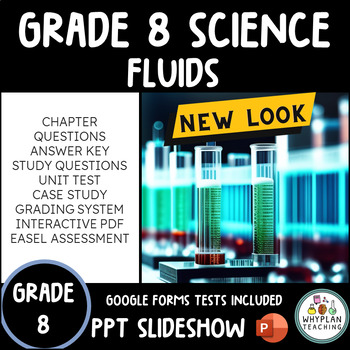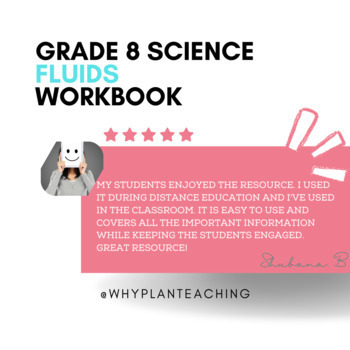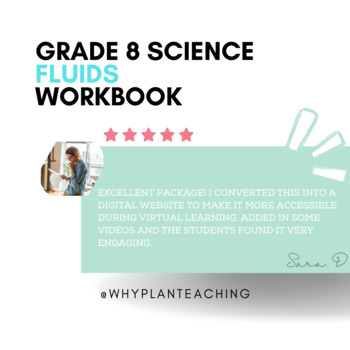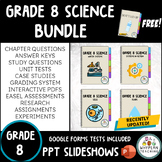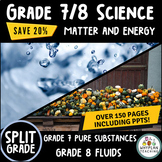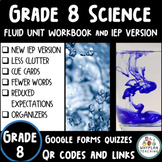Grade 8 Fluids Ontario Science Unit Workbook | Powerpoint Slides Included
- Zip
- Internet Activities
- Easel Assessment
What educators are saying
Also included in
- The ultimate grade 8 science resources are tailored to the Ontario Science Curriculum of 2022. These four units of (fluids, cells, systems, and water systems) are for educators seeking comprehensive and engaging content. I've recently updated and reformatted my units to provide a better learning expPrice $15.30Original Price $21.76Save $6.46
- Discover the new 2022 Split 7/8 Ontario Science curriculum, featuring in-depth units on Fluids, Pure Substances, and Mixtures. Give your students a comprehensive understanding of these key scientific concepts.Looking for a comprehensive and engaging resource to help your Grade 7 and 8 students exploPrice $7.46Original Price $10.98Save $3.52
- Students will learn a variety of specific and global expectations in grade 7 and 8 Ontario Science Curriculum. Great news, all of my grades 7 and 8 Ontario science chapters have been bundled together, creating the ultimate Intermediate Science Bundle. I'll get straight to the point. Many students doPrice $30.60Original Price $41.72Save $11.12
- ✬Enjoy all of our Ontario Grade 8 and Grade 7 Science Units in this bundle!(This bundle includes both French and English science units)Before I describe this resource, I'd like to share my innovation with you; QR codes! This unit has QR codes and embedded links for your/your students' convenience! TPrice $55.62Original Price $81.77Save $26.15
- This science unit workbook follows global and specific expectations of Ontario's grade 8 science curriculum and has an IEP version. Students will learn about fluids' properties by analyzing flow, viscosity, and density and evaluating factors that affect fluids, such as temperature and pressure, amonPrice $6.12Original Price $8.98Save $2.86
Description
This science unit workbook follows global and specific expectations of Ontario's grade 8 science curriculum (Matter and Energy - Fluids). Students will learn about fluids' properties by analyzing flow, viscosity, and density and evaluating factors that affect fluids, such as temperature and pressure, among other expectations.
Test this resource in your classroom by downloading the free Chapter 1 fluids resource!
I'll get straight to the point. Many students don't enjoy reading textbooks because the content is often very dry and bland. Upon purchasing this teaching resource, you'll notice that this packet is written differently. It's informal, loaded with jokes, and tries to teach students on a personal level. I wanted to write it as if I were conversing with your students. Moreover, it entices them to try to perform their own inquiry-based independent science experiments at home. It's a short unit (compared to textbook units), but it is filled with embedded links, QR codes, and a PowerPoint presentation. It has everything you need to cover the specific and global expectations of the Ontario science curriculum.
I would consider this resource "low-prep" as you are not required to print it. However, some science experiments may require some setup. I've included some chapter quizzes/assignments in PDF and Google Forms. Use these tasks as consolidation assignments or discussion topics in your classroom! The content of this packet is relevant and accurate. It will not impede their understanding!
July 2022: Good news! I just became a certified easel creator! I decided to start putting them in some of my resources. This resource currently has the following:
- Chapter 1 Easel assessment
- Chapter 2 Easel assessment
- Chapter 3 Easel assessment
- Chapter 4/4.5 Easel assessment
Easel allows teachers to modify purchased resources, including movable pieces, apply pen activities, highlight, share links, and add/remove questions. Its goal is to foster differentiation in the classroom.
✬This Unit has 5 Chapters:
- Chapter 1: Fluids, What Are they
- Chapter 2: Flow, Rate, Viscosity
- Chapter 3: Buoyancy, Density, Mass, and Volume
- Chapter 4: Pressure and Compressibility
- Chapter 5: Pressure, Volume, and Temperature
Welcome to my grade 8 student unit workbook on fluids! I've designed this comprehensive guide to help your students understand the properties and behaviours of fluids in a fun and engaging way.
Here's a breakdown of what you'll find in each chapter:
- Chapter 1: Fluids, What are they - In this chapter, students will learn about the defining characteristics of fluids and how they differ from solids and gases. They'll explore the viscosity concept and how it affects the flow of fluids.
- Chapter 2: Flow, Rate, Viscosity - This chapter delves deeper into the concept of flow and how it is affected by fluid viscosity. Students will learn how to calculate flow rate and use thickness to predict the behaviour of fluids in different situations.
- Chapter 3: Buoyancy, Density, Mass, and Volume—This chapter covers buoyancy, density, mass, and volume and explains how these properties can predict how fluids behave in different situations. Students will learn how to calculate density and how it affects the buoyancy of an object in a fluid.
- Chapter 4: Pressure and Compressibility—In this chapter, students will learn about the relationship between pressure and compressibility and how it affects fluid behaviour. They'll explore how pressure is affected by temperature and volume and how it can be used to predict fluid behaviour in different situations.
- Chapter 5: Pressure, Volume, and Temperature - This final chapter covers the critical relationship between pressure, volume, and temperature and how these factors can be used to predict the behaviour of fluids under different conditions. Students will learn how to use the ideal gas law to understand the relationship between these variables and how to apply this knowledge to real-world situations.
With clear explanations and engaging examples, this workbook is the perfect resource for any grade 8 student looking to gain a deeper understanding of fluids.
✬It also includes:
- Vocabulary Pages
Answer Keys for every chapter
- Questionnaires for each chapter (paperback and Google Forms)
- Study Questions
- Unit Test
- A Case Study
- Embedded link and QR code page (linked to educational videos)
- PPT lesson
- Easel assessments for each chapter
- 2022 Curriculum update task
See revision history for details.
✬Need more Science resources? Check these out:
- Grade 8 Systems in Action Unit Workbook
- Grade 8 Water Systems Unit Workbook
✬Have a split grade this year? You might want this:
- Grade 7/8 Ontario Science Curriculum Bundle
Enjoy,
If you're having problems printing them (sizing and all) - Here's a link to a troubleshooter on TPT.

